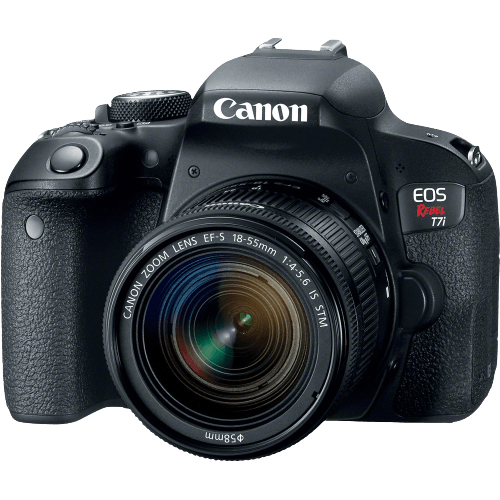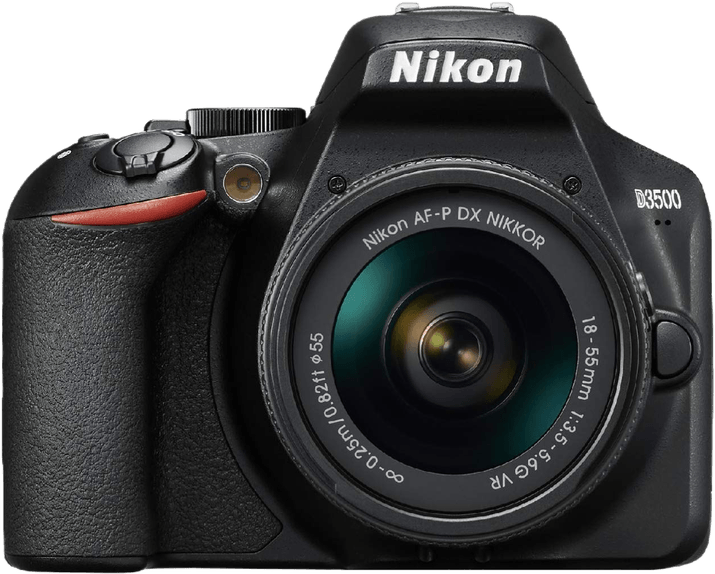Canon EOS Rebel T7i / 800D vs Nikon D3500 Comparison
Canon EOS Rebel T7i / 800D

Nikon D3500

The Canon EOS Rebel T7i / 800D emerges as the winner with a score of 64/100, while the Nikon D3500 trails close behind with a score of 61/100. Both cameras share the same DSLR camera type, similar dimensions, and release years of 2017 and 2018, respectively. The T7i/800D, however, boasts a higher launch price of $779 compared to the D3500’s $499.95, possibly reflecting its superior performance.
The Canon T7i/800D outshines the Nikon D3500 in terms of weight, coming in at a lighter 532g or 1.17lbs, as opposed to the D3500’s 615g or 1.36lbs. On the other hand, the Nikon D3500 has a more compact size, measuring 124 x 97 x 70mm, while the Canon T7i/800D is slightly larger at 131 x 100 x 76mm.
Taking these factors into account, the Canon EOS Rebel T7i / 800D is the better camera, but the Nikon D3500 remains a viable option for those seeking a more budget-friendly and compact choice.
Canon EOS Rebel T7i / 800D vs Nikon D3500 Overview and Optics
The Nikon D3500 wins in optics with a score of 65/100, while the Canon EOS Rebel T7i / 800D follows closely with a score of 64/100. Both cameras share several common specifications, such as 24 megapixels, a CMOS sensor, an APS-C sensor size, and the lack of image stabilization. They also have different lens mounts, with the Canon using the EF/EF-S mount and the Nikon using the F mount.
The Nikon D3500 outperforms the Canon T7i in terms of sensor performance, boasting a DXOMARK score of 87 compared to the Canon’s 79. This advantage might result in better image quality and improved low-light performance. However, the Canon T7i has a faster shooting speed of 6 frames per second (fps) compared to the Nikon’s 5 fps. This difference may give the Canon an edge for capturing fast-moving subjects or action shots.
The Canon T7i also features a more advanced processor, the Digic 7, while the Nikon D3500 uses the Expeed 4. The upgraded processor in the Canon might lead to faster performance and improved image processing capabilities.
In terms of optics, the Nikon D3500 holds a slight advantage over the Canon EOS Rebel T7i / 800D, mainly due to its superior sensor performance. However, the Canon T7i does offer a faster shooting speed and a more advanced processor, which may appeal to some users depending on their photography needs. Both cameras lack image stabilization, so photographers should consider investing in stabilized lenses or tripods for the best results.
Canon EOS Rebel T7i / 800D vs Nikon D3500 Video Performance
The Canon EOS Rebel T7i / 800D outperforms the Nikon D3500 in video capabilities with a score of 70/100, a 14-point difference from the Nikon D3500’s score of 56/100. Both cameras share common specifications, such as Full HD max video resolution, 1920 x 1080 max video dimensions, and a 60fps max video frame rate.
The Canon T7i/800D’s superiority in video capabilities is primarily due to its built-in time-lapse functionality. This feature allows users to create stunning time-lapse videos without needing additional software or equipment. The Nikon D3500 lacks this built-in feature, which can be a disadvantage for those who frequently shoot time-lapse videos.
While the Nikon D3500 has a lower video score, it is important to note that it still offers Full HD resolution, 1920×1080 video dimensions, and 60fps frame rate. These features are sufficient for casual videographers and those who do not require advanced video options. However, the absence of built-in time-lapse functionality is a drawback for this camera.
Considering the video capabilities of both cameras, the Canon EOS Rebel T7i / 800D is the better choice for users who prioritize video features, particularly time-lapse functionality. On the other hand, the Nikon D3500 remains a suitable option for those who are content with basic video features and do not require advanced options.
Canon EOS Rebel T7i / 800D vs Nikon D3500 Features and Benefits
The Canon EOS Rebel T7i / 800D emerges as the winner with a feature score of 70/100, compared to the Nikon D3500’s score of 54/100. Both cameras share some common specifications, such as a 3-inch screen size and Bluetooth connectivity. However, the Canon T7i boasts several advantages over the Nikon D3500, making it a superior choice in terms of features.
Firstly, the Canon T7i has a higher screen resolution of 1,040,000 dots, compared to the Nikon D3500’s 921,600 dots. This means that the Canon T7i provides a clearer and sharper display for better image review and menu navigation. Additionally, the Canon T7i offers a touchscreen, allowing for more intuitive control and easier access to settings. The Nikon D3500 lacks this feature.
Moreover, the Canon T7i has a flip screen, which is useful for capturing images and videos from different angles, including selfies and vlogging. This feature is absent in the Nikon D3500. The Canon T7i also supports GPS and WiFi, further enhancing its connectivity options and enabling easy geotagging and wireless image transfer. The Nikon D3500 does not offer these features.
Despite its lower score, the Nikon D3500 does have one advantage over the Canon T7i in terms of its simpler user interface, making it more beginner-friendly. However, this advantage may not outweigh the additional features offered by the Canon T7i.
Taking all these factors into account, it is evident that the Canon EOS Rebel T7i / 800D offers more advanced features and better performance than the Nikon D3500. Therefore, the Canon T7i is the superior choice for those prioritizing features and functionality in their camera selection.
Canon EOS Rebel T7i / 800D vs Nikon D3500 Storage and Battery
The Nikon D3500 outperforms the Canon EOS Rebel T7i / 800D in storage and battery with a score of 48/100, while the Canon scores 29/100. Both cameras have one memory card slot and accept SD, SDHC, and SDXC cards. Neither camera supports USB charging.
The Canon T7i uses the LP-E17 battery, providing 600 shots per charge. In contrast, the Nikon D3500’s battery, the EN-EL14a, lasts significantly longer with an impressive 1550 shots per charge, making it the superior choice for extended shooting sessions.
However, the Canon T7i’s memory cards are UHS-I compatible, which allows for faster read and write speeds compared to the Nikon D3500’s non-UHS-I compatible cards. This advantage might benefit photographers who need quicker data transfers.
Despite the Canon T7i’s faster memory card compatibility, the Nikon D3500’s significantly longer battery life makes it the better option for those prioritizing storage and battery capabilities.
Canon EOS Rebel T7i / 800D vs Nikon D3500 Alternatives
Still not sure which camera is best for you? Our camera comparison tool can be useful for narrowing down your options. Check out some more popular camera comparisons for inspiration:
